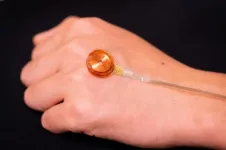(Press-News.org) UNIVERSITY PARK, Pa. -- Developing new ultrathin metal electrodes has allowed researchers to create semitransparent perovskite solar cells that are highly efficient and can be coupled with traditional silicon cells to greatly boost the performance of both devices, said an international team of scientists. The research represents a step toward developing completely transparent solar cells.
"Transparent solar cells could someday find a place on windows in homes and office buildings, generating electricity from sunlight that would otherwise be wasted," said Kai Wang, assistant research professor of materials science and engineering at Penn State and co-author on the study. "This is a big step -- we finally succeeded in making efficient, semitransparent solar cells."
Traditional solar cells are made from silicon, but scientists believe they are approaching the limits of the technology in the march to create ever more efficient solar cells. Perovskite cells offer a promising alternative and stacking them on top of the traditional cells can create more efficient tandem devices, the scientists said.
"We've shown we can make electrodes from a very thin, almost few atomic layers of gold," said Shashank Priya, associate vice president for research and professor of materials science and engineering at Penn State. "The thin gold layer has high electrical conductivity and at the same time it doesn't interfere with the cell's ability to absorb sunlight."
The perovskite solar cell that the team developed achieved 19.8% efficiency, a record for a semitransparent cell. And when combined with a traditional silicon solar cell, the tandem device achieved 28.3% efficiency, up from 23.3% from the silicon cell alone. The scientists reported their findings in the journal Nano Energy.
"A 5% improvement in efficiency is giant," Priya said. "This basically means you are converting about 50 watts more sunlight for every square meter of solar cell material. Solar farms can consist of thousands of modules, so that adds up to a lot of electricity, and that's a big breakthrough."
In previous research, ultrathin gold film showed promise as a transparent electrode in perovskite solar cells, but issues in creating a uniform layer resulted in poor conductivity, the scientists said.
The team found that chromium used as a seed layer allowed the gold to form on top in a continuous ultrathin layer with good conductive properties.
"Normally, if you grow a thin layer of something like gold, the nanoparticles will couple together and gather like small islands," said Dong Yang, assistant research professor of materials science and engineering at Penn State. "Chromium has a large surface energy that provides a good place for the gold to grow on top of, and it actually allows the gold to form a continuous thin film."
Perovskite solar cells are composed of five layers and other materials tested as transparent electrodes damaged or degraded layers of the cells. The scientists said solar cells made with the gold electrodes are stable and maintain high efficiencies over time in laboratory tests.
"This breakthrough in the design of tandem cell architecture based on a transparent electrode offers an efficient route toward the transition to perovskite and tandem solar cells," said Yang.
INFORMATION:
Also contributing to this research from Penn State were Tao Ye and Jungjin Yoon, postdoctoral scholars; and Yuchen Hou, a doctoral student.
Xiaorong Zhang, Shaanxi Normal University, China; Shengzhong Liu, Chinese Academy of Sciences; Congcong Wu, Hubei University, China; and Mohan Sanghadasa, U.S. Army Combat Capabilities Development Command, also contributed to the research.
The Office of Naval Research, the Army Rapid Innovation Fund, and the Air Force Office of Scientific Research provided funding for this research.
As the cleanest renewable energy, hydrogen energy has attracted special attention in the research. Yet the commercialization of traditional proton exchange membrane fuel cells (PEMFCs), which consume hydrogen and produce electricity, is seriously restricted due to the chemical reaction of PEMFCs cathode largely relies on expensive platinum-based catalysts.
A solution is to change the acidic electrolyte of PEMFCs to alkaline. Such fuel cells are called anion exchange membrane fuel cells (AEMFCs), and they allow for the use of cheaper metal elements like Co, Ni or Mn to design electrocatalysts.
The research team led by Prof. GAO Minrui from University of Science and Technology ...
During the era of commercial whaling, fin whales were hunted so intensively that only a small percentage of the population in the Southern Hemisphere survived, and even today, marine biologists know little about the life of the world's second-largest whale. That makes the findings of researchers from the Alfred Wegener Institute, Helmholtz Centre for Polar and Marine Research (AWI) and the Johann Heinrich von Thünen Institute for Sea Fisheries, which show that a large number of the baleen whales regularly frequent the krill-rich waters surrounding Elephant Island, all the more welcome. Evidence for this is provided by underwater sound ...
An international archaeological study, led by researchers from the Culture and Socio-Ecological Dynamics (CaSEs) research group at Pompeu Fabra University, has advanced in the understanding and preservation of archaeological sites and in improving their analysis and surveying, thanks to the application of pXRF (portable X-ray fluorescence analysis) to anthropogenic sediments in Africa. It is a rapid, inexpensive, non-invasive procedure, which enables generating an additional archaeological record from the anthropogenic deposit by analysing chemical elements, combined with geostatistics.
It is a rapid, inexpensive, non-invasive procedure, ...
The work was conducted under the auspices of the Russian Foundation for Basic Research and organizations-participants of the BRICS framework program in science, technology and innovation; the grant title is "Nanosized peptide-based biomaterials for photodynamic diagnostics of tumors".
Project lead, Chief Research Associate of KFU's Bionanotechnology Lab Rawil Fakhrullin commented on the results, "The development of materials for theranostics (simultaneous early diagnosis and therapy of diseases) is one of the most urgent tasks in modern chemistry and biomedicine. A feature of such materials is the combination of at least two functions: sensory and therapeutic. ...
A research group led by Takashi Saito, of the Ehime University Graduate School of Medicine, developed a 2-photon excitation light-sheet fluorescence microscope which (1) lowers phototoxicity, (2) extends the field of view, and (3) heightens spatial resolution. This microscope, when used for the observation of medaka fish, made it possible to observe the whole body of the embryo (an extended field of view) at a cellular level resolution (high spatial resolution) without affecting the growth of the fish (low phototoxicity) over a three-day span of embryonic development. ...
The research team of the Department of Organic Chemistry of Samara Polytech under the leadership of Doctor of Chemical Sciences, Head of the Department Yuri Klimochkin and Doctor of Chemical Sciences, Professor Alexander Reznikov in cooperation with the crystallographic research group of Lomonosov Moscow State University (supervisor - candidate of chemical sciences, senior researcher Victor Rybakov) completed a study to obtain non-racemic 4,5-dihydrofurans based on Michael addition and study their chemical properties. The announcement of a scientific article with the results of the latest research is posted on the cover of the authoritative journal Tetrahedron.
"Studying the method of obtaining ...
CHAPEL HILL, NC - A new study published in Nature Communications demonstrates that a consortium of bacteria designed to complement missing or underrepresented functions in the imbalanced microbiome of inflammatory bowel disease (IBD) patients, prevented and treated chronic immune-mediated colitis in humanized mouse models. The study's senior author, Balfour Sartor, MD, Midget Distinguished Professor of Medicine, Microbiology and Immunology, Co-Director of the UNC Multidisciplinary IBD Center, said the results are encouraging for future use treating Crohn's disease and ulcerative colitis patients.
"The idea with this treatment is to restore the normal ...
Dark Matter Particle Explorer (DAMPE) Collaboration directly observed a spectral softening of helium nuclei at about 34TeV for the first time. This work was based on measurements data of the helium spectrum with kinetic energies from 70 GeV to 80 TeV (17.5 GeV/n to 20 TeV/n for per nucleon) recorded by the DAMPE.
The relevant results were published in Physical Review Letters.
Galactic cosmic rays (GCRs) offers important ways to deeply understand the astrophysical particle origin and accelerators and the interstellar medium of the Galaxy. Helium nuclei, the second most abundant nuclear element of cosmic rays, is a distinguishing feature of space.
As for GCRs, the energy spectrum is supposed to follow a negative power law distribution when energies are below the "knee" (at ...
By putting a piece of soft, strain-sensing sheet on the skin may be able to detect skin disorders non-invasively and in real-time very soon. A research team co-led by a scientist from City University of Hong Kong (CityU) has designed a simple electromechanical device that can be used for deep tissue pathology diagnosis, such as psoriasis, in an automated and non-invasive fashion. The findings will lay a foundation for future applications in the clinical evaluation of skin cancers and or dermatology diseases.
The research is co-led by Dr Yu Xinge, Assistant Professor from CityU's Department of Biomedical Engineering, and scientists from and Northwestern University in the US. Their findings have been published in the science journal Nature Biomedical Engineering, titled "Miniaturized ...
New Haven, Conn. -- The ancient burrowers of the seafloor have been getting a bum rap for years.
These prehistoric dirt churners -- a wide assortment of worms, trilobites, and other animals that lived in Earth's oceans hundreds of millions of years ago -- are thought to have played a key role in creating the conditions needed for marine life to flourish. Their activities altered the chemical makeup of the sea itself and the amount of oxygen in the oceans, in a process called bioturbation.
But did that bioturbation help or hinder the expansion of complex animal life? A new Yale study, published in the journal Earth and Planetary Science Letters, found that ...






